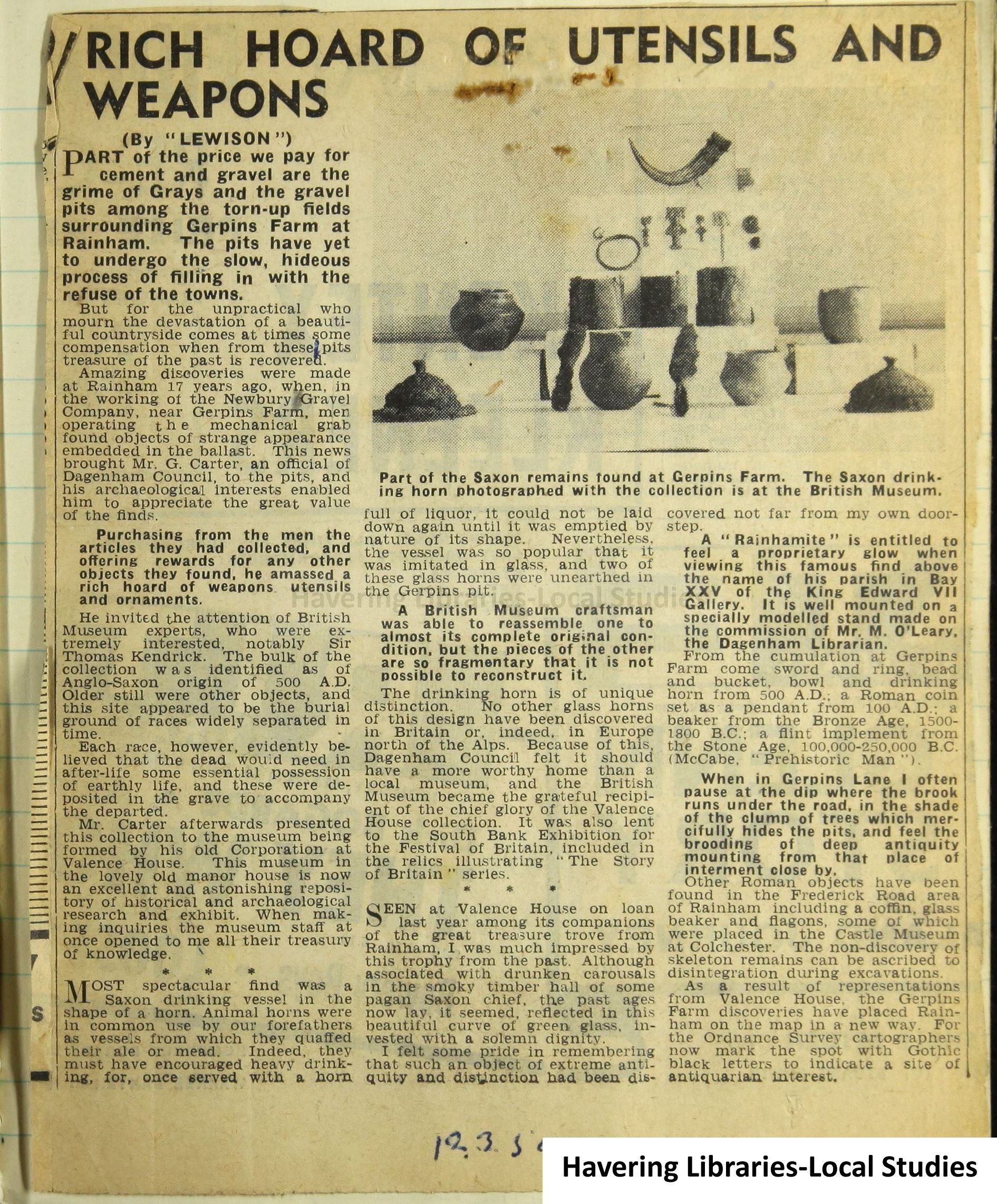Did you know? – Rainham
Rainham is one of the most historic areas in Havering, if not the whole country. Not only does it have its roots going back to the Saxon period, there is strong evidence of a settlement before that with a Neolithic (or the new Stone Age dating back some 4,000-2,500 BC) site discovered west of Launders Lane in 1963. There are also remains of a Neolithic forest close to the mouth of the Mardyke River in Rainham Marshes.
An Anglo/Saxon burial ground from the 6th and 7th Centuries was discovered during excavations at Gerpins Lane Pit in 1930. A precious collections of objects such as swords, brooches, rings, spear heads and a pair of drinking horns were unearthed, as well as indications of earlier burials.
The original drinking horns are in the British Museum, but there is an exact copy on display in the Rainham Case in the Museum. Today the burial site is under the Gerpins Lane Tip in Gerpins Lane, Upminster. Archaeologists and local historians have often wondered what wealth of other priceless Saxon artefacts are still buried underneath the mounds of household rubbish at one of Havering’s official tips.
During the Middle Ages, the settlement of Rainham was grouped around the church of St. Helen and St. Giles. This is the oldest building in Havering, built in 1170. Among its many original features is a rare engraving of a medieval ship at anchor etched in the wall of a stairwell.

What they built the Gerpins Lane Tip on top of the old burial ground??
What happened to the artifacts, were they put in a museum?
Gerpins tip items were excavated by a Dagenham Council official at a time when Dagenham had become a Borough. Certainly some of the Saxon items were on display at Dagenham ‘s fledgling museum but these I believe passed into the hands of the British Museum. Lewis in his History of Rainham records that a valuable gold Solidus Roman coin mysteriously disappeared. Other items of archaeological interest from this and other sites were examined and dated by the staff’s of the British Museum, Guildhall Museum (now Museum of London) and Passmore Edwards Museum at Stratford, so the finds may be scattered among these. Valence House Museum may be able to shed more light.
Brian Evans
Please find attached an article by Frank Lewis which I think is from the Essex and Thurrock Gazette of 12th March 1954. It is taken from his scrapbooks which we have in our collection. This article suggests that any finds were either given to Valence House Museum or are in the British Museum. There may be more in his book, A History of Rainham, but I haven’t had an opportunity to check that yet. I hope this is helpful and that you can confirm this with the museums.

Simon Donoghue | Local History Librarian
London Borough of Havering
Local Studies Library
Central Library
St Edwards Way
Romford
Essex
RM1 3AR
Below is everything we have in our collection from Gerpins Farm. The items were not uncovered or collected in an official archaeological manner, Someone collected everything that had been extracted by the quarrying and made a note of where certain concentrations of artefacts were from . I think that the Saxon artefacts were written up pre-War and that would give you absolutely everything that there is for the site. I think that there should be a copy in boxes in our Local Studies Library. I would say that there was a Saxon cemetery and a Roman Cemetery. The polished stone axes could have come from either period of graves. The hand axes would have come out as part of the gravelling.
1 of 6 iron spear heads. 4 5/8″ x 1 1/4″ (max) fragment (of blade) with curved end (sword?).
1 of 6 iron spear heads. 3 3/4″ x 1″ (max) ?haft (sword?).
1 of 6 iron spear heads. 5.5″ x 1 5/8″ (max) tip.
1 of 6 iron spear heads. 8 1/4″, Blade and tip (no socket).
1 of 6 iron spear heads. 9 3/8″, socket (tip and some of blade missing).
1 of 6 iron spear heads. 14.5″, remains of socket (tip missing).
1 of 6 shield bosses.
1 of 6 shield bosses.
1 of 6 shield bosses.
1 of 6 shield bosses. Restored and mounted 1957 by Peter Shorer. Conserved 1983/4 AMS/PEM.
1 of 6 shield bosses.
Cooking pot of course ware, hand made.
Globular pot of reddish ware, hand made.
Hand axe (large ocherous: 8.5″ x 4.5″. The British Museum classified the Gerpins Farm stone implements.
Bowl of grey ware, hand made.
Frankish bowl, wheel made, decorated with Chevron ornament.
1 of 2 flagons of the “Screw-neck” type, dated to the 1st and 2nd centuries AD.
1 of 2 flagons of the “Screw-neck” type, dated to the 1st and 2nd centuries AD.
Early Acheulean (or even Abbevillian) hand axe, much abraded. Deeply patinated facet on one edge with what looks like a struck surface.
Early Acheulean hand axe. Has an ochreous patina; much abraded. The British Museum classified the Gerpins Farm stone implements.
Acheulean hand axe.
Acheulean hand axe.
A collection of 15 flint axes and scrapers
1 of 3 bronze-bound wooden vessels.
Square headed small, long brooch, 2.5 inches long. Decorated with a circle and dot motif..
Guilt square headed brooch, 3.5 inches long.
Girdle-hanger, 5.2 inches long.
Disc, 0.8 inches in diameter, possible the lid of a Roman seal box.
Bronze Ring, 1 inch in diameter.
Bronze Ring, 1.5 inches in diameter.
Bronze Ring, 3.6 inches in diameter.
Anglo-Saxon bronze coin, perforated for suspension (as an adornment).
Bronze finger ring.
Iron spike, 3.5 inches long, probably used in weaving, to push the treads together.
Glass bead, 1.1 inches in diameter, in the form of an irregular disc of blue glass decorated with an off-white zigzag thread.
Glass bead. 1.6 inches in diameter, in the shape of a truncated cone. Dark brown or black glass decorated with creamy threads.
1 of 3 bronze-bound wooden vessels.
1 of 3 bronze-bound wooden vessels.
Axe that has been badly broken. All that remains is one large piece (the tip) & two small fragments.
Flint Scraper.
Flint Scraper.
Hand axe.
Mesolithic hand axe.
A photograph of the glass drinking horn found in the burial. Made of olive green glass, it is ornamented with thick self coloured trails.
Square headed small, long brooch, 2.2 inches long. Decorated with a circle and dot motif.
Plastic replica of a glass drinking horn.
Regards
Leeanne Westwood | Museum Curator | Heritage Services
Valence House Museum | Becontree Avenue | Dagenham | RM8 3HT
I find this hard to accept that they have built on a burial site. And a tip at that. Not very respectful is it.